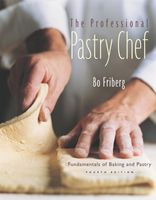There are actually 513 layers of butter and dough in puff pastry made with 4 double turns, as directed in the following recipe. When the dough is given 6 single turns, which is the classic French technique, the finished dough has almost 1,500 layers of dough and butter combined. The French word for puff pastry is feuilletage , from feuilles , meaning “leaves”; the pastry we call a napoleon is known as mille-feuille , or “a thousand leaves.”
Working with Puff Pastry
Even after you have made perfect puff pastry, there are many things to watch for as you work with it:
Be careful not to damage the layer structure when rolling the dough. Never let your rolling pin roll over the edge of the dough, which mashes down the sides, and always apply even pressure as you are rolling so that the butter is evenly distributed.
As a general rule, puff pastry dough should rest 5 to 10 minutes between rolling out and cutting. It should then rest an additional 15 minutes after it has been made up (for example, into turnovers) before baking to eliminate shrinkage. (If the dough seems particularly rubbery and shrinks back a lot as you roll it, it will need to rest a bit longer.)
As you cut the dough, hold the knife at a sharp 90-degree angle, so the edges of the dough are perfectly straight. This way, the dough will rise straight up in the oven.
When using egg wash on a product made with puff pastry dough, take care not to let any drip on the side. This can seal the dough to the pan and prevent it from rising.
Start baking puff pastry in a hot oven. If the oven is not hot enough, you will lose the effect of the steam, and the butter will run out of the dough.
Ideally, puff pastry made according to the recipe in this book should be ready to use the day after it is started, with all four turns having been made before it is placed in the refrigerator overnight. If the situation demands, the dough can be given two turns only, then finished the following day to be ready for use on day three. Puff pastry should not be started if there is time to make only one turn before leaving it overnight. The butter layer will be too thick and will break when the dough is rolled out the following day.


